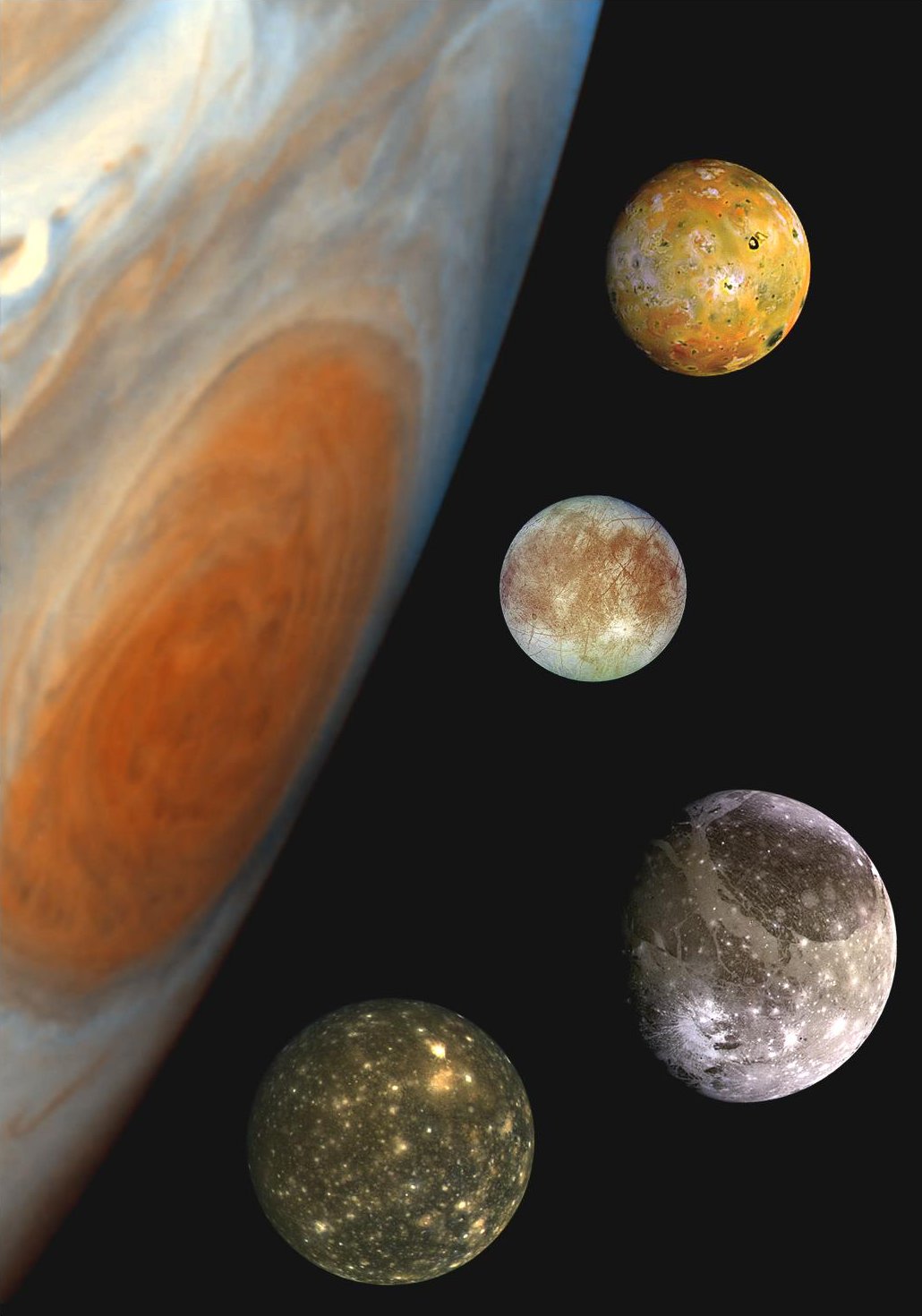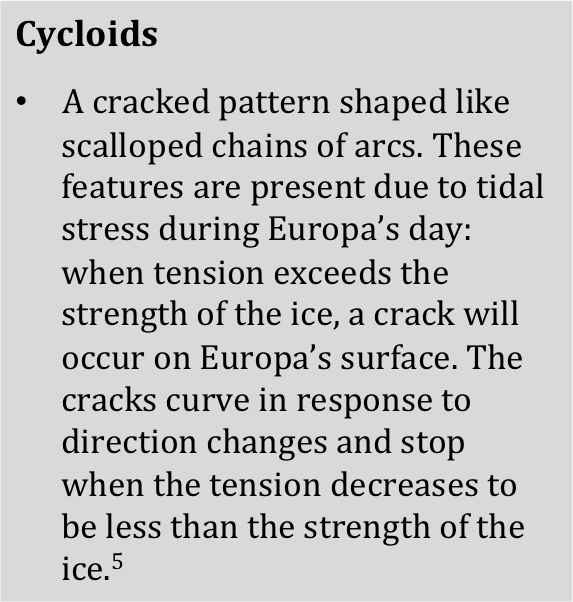Europa: Is There Life on Jupiter’s Water Moon?
By Andrea Calado, Ashley Halko-Addley, Evan Friesen, Kirsten Samson, Philippa Williams, Simone Hagey and Zachary Walters
The quest for extraterrestrial life in the universe is one that compels many a curious scientist. Many key points of interest begin to emerge through a general discussion of Jupiter and its moons. The possibility that life may actually exist elsewhere in our own solar system becomes realistic as we delve deeper into one moon in particular; Europa. Reviewing the environmental aspects which establish its potential to support microbial life, as well as the limiting conditions that would inhibit humans from colonizing this moon, we see that the potential for life to exist elsewhere in the universe is more than just science fiction.
Jupiter and its Moons
Jupiter, with a distance of 5.2 astronomical units from the Sun2 and an equatorial diameter of 142,894 kilometres,1 is the largest planet in the Solar System. The fifth planet from the Sun, Jupiter has a ten-hour long day, making it the fastest rotating planet in the Solar System. Jupiter’s year is approximately twelve times the length of a year on Earth,2 meaning it takes Jupiter twelve years to complete one orbit around the Sun. Jupiter does not have a solid surface like Earth has, but it does have an atmosphere with cloud-like features.1
Jupiter has sixty-two currently known moons. Four of these moons: Io, Europa, Ganymede, and Callisto, are known as the Galilean Satellites.2 These are the four largest moons orbiting Jupiter with their name originating from their discoverer, Galileo Galilei.2
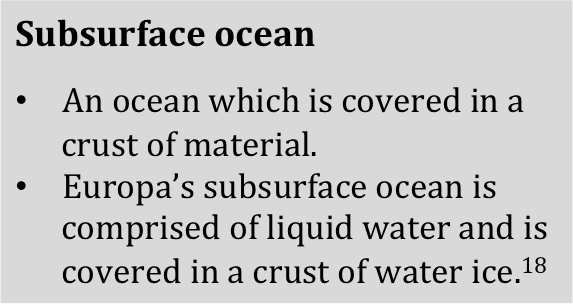 Each Galilean Satellite is unique. Much as the planets of our Solar System differ based on their distance from the Sun, Jupiter’s four large moons vary in their qualities and compositions based on their distance from Jupiter. Europa and Ganymede both have subsurface oceans.
Each Galilean Satellite is unique. Much as the planets of our Solar System differ based on their distance from the Sun, Jupiter’s four large moons vary in their qualities and compositions based on their distance from Jupiter. Europa and Ganymede both have subsurface oceans.
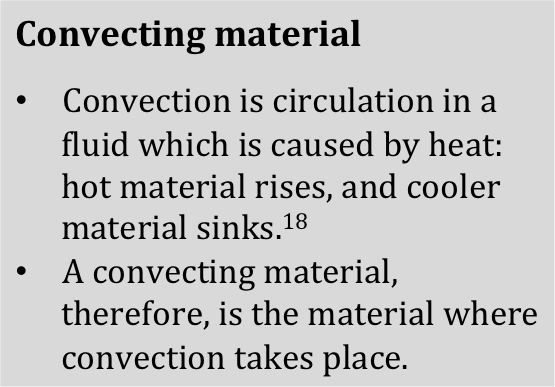 Ganymede is the only moon in our Solar System that has a strong magnetic field, indicating the existence of a convecting material, which is most likely liquid water.3 The most intense volcanism known in the Solar System is present on Io,3 showing just how unique each Galilean Satellite is.
Ganymede is the only moon in our Solar System that has a strong magnetic field, indicating the existence of a convecting material, which is most likely liquid water.3 The most intense volcanism known in the Solar System is present on Io,3 showing just how unique each Galilean Satellite is.
Qualities of Europa
Europa, the second Galilean satellite from Jupiter, is approximately as big as Earth’s Moon4 with a total diameter of about 1,300 km.5 Europa’s temperature ranges from 50 K–140 K.7 The surface of Europa appears smooth with crisscrossed cracks.6 According to NASA, Europa’s subsurface ocean may contain twice that amount of water as there is on Earth.6
Europa’s surface is mostly composed of solid water ice. This was determined by ground based spectroscopic studies by Gerard Kuiper.6 The density values inferred from gravity measurements suggest that a liquid water layer beneath Europa’s surface may extend down as far as 150 km.5 Neubauer reported that there are “strong magnetic signatures” coming from Europa, meaning that the ocean must come up almost to the surface of the moon, indicating that Europa’s ocean is very deep.3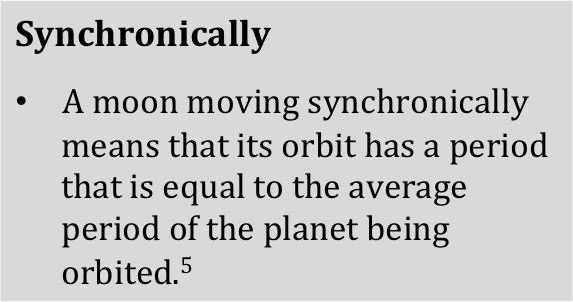
Europa is a water world with strong and active tides.4 The tide on Europa is about 500 m tall at its peak on the sides of the moon that are closest and furthest from Jupiter.5 Europa moves synchronically, with its orbital period being equal to the average rotation rate of Jupiter. Due to its synchronic movement, Europa has become tidally locked, so that it keeps the same face towards Jupiter for hundreds of years.6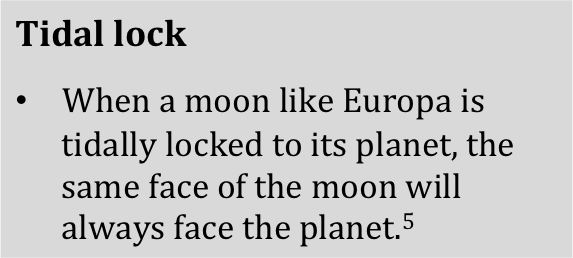
Greenberg, as well as many other scientists, argue that Europa has the potential to support life and/or complex ecosystems, meaning that the addition of life could evoke environmental changes in different times and places.4
Evidence of Microbial Life?
Nearly all of Europa is covered with tectonic and chaotic terrain formed and sustained by tidal forces arising from Europa’s interactions with Jupiter and its other large moons. Tectonic terrains include cracks, rifts, and ridges, which occur because Europa has tectonic activity similar to Earth’s crust.12 Sections of ice are subducted into the ocean below, possibly dragging down nutrients and organic molecules that accrete on the surface from comet impacts over the years.10 That being said, Europa’s tidal system squeezes liquid water to the surface of the ocean through cracks in the icy crust. Over many years, the tides could force the speculated organisms up through these cracks, where they could end up in a hibernating frozen state. That means that Europa’s tidal ecosystem may be able to support habitable niches.4
When looking at tidal fluctuations it is important to remember that when Europa is closest to Jupiter the tidal distortion is the greatest and that it decreases the farther Europa gets from Jupiter in its orbit. At the greatest distortion the total height is 500 m because of the 10 m shift. Due to this tidal fluctuation, frictional heat is created which stresses the icy crust on top of the liquid ocean.5 Keeping this in mind, all of the ice cracks could have the potential to act as a niche that could support rich ecologies.5
It is debated whether the ice on Europa is thick (2,030 km) or thin (just a few kilometres), but most evidence points towards thin ice. Thin ice would make it easier for the ocean to be chemically enriched, making the planet more likely to sustain life.13 Other sources suggest that Europa’s ice shell is about 1,525 km thick and its ocean is approximately 60,150 km deep. This was hypothesized through the observations of pits, domes, and spots on the satellite’s surface. This stance argues that the pits could only have been created if the ice shell is thicker than 15 km.7 These observations lead to the existence of cycloids becoming the first convincing evidence that there is a global ocean on Europa.5
If there is any life on Europa it will most likely be oceanic. Both of the moons Callisto and Ganymede are suspected to have subsurface oceans as well, but their oceans most likely lie between two layers of ice, with one layer of ice on the surface and one layer of ice on the bottom. On Europa, however, the ocean is thought to reach the rocky bottom, meaning there must be contact between the ocean water and nutrients locked in the rocky core of the moon.9 However, the surface ice layer isolates the ocean from sunlight and oxygen, leaving a limited possibility for the existence of complex organisms.5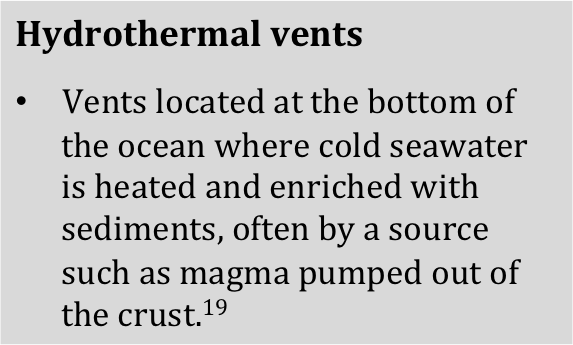
Hydrothermal vents may have been very important for the development of life on Earth.10 If Europa has volcanic activity, similar life may be able to evolve at the very bottom of its global ocean.9
Extremophiles on Europa?
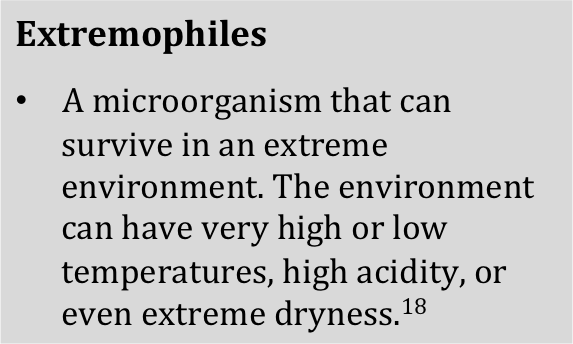 Europa may seem like an incredibly harsh environment to us, with freezing temperatures and no breathable air, but scientists are keen to search for signs of life on the distant moon. They are not looking for giant sea creatures or tiny green men, however, but for resilient microorganisms that could survive in extreme conditions. There are analogous creatures on Earth called extremophiles; microorganisms which have evolved to withstand conditions that would quickly kill humans. Extremophiles thrive in severe conditions such as extreme heat, cold, salinity, acidity, and dryness.8
Europa may seem like an incredibly harsh environment to us, with freezing temperatures and no breathable air, but scientists are keen to search for signs of life on the distant moon. They are not looking for giant sea creatures or tiny green men, however, but for resilient microorganisms that could survive in extreme conditions. There are analogous creatures on Earth called extremophiles; microorganisms which have evolved to withstand conditions that would quickly kill humans. Extremophiles thrive in severe conditions such as extreme heat, cold, salinity, acidity, and dryness.8
We have found life on every corner of the Earth, even in conditions that seem completely uninhabitable. At the very bottom of the ocean surrounding black smokers, volcanic vents pumping out sediment and nutrient-rich water at extremely hot temperatures, dwell extremophiles called hyperthermophiles.8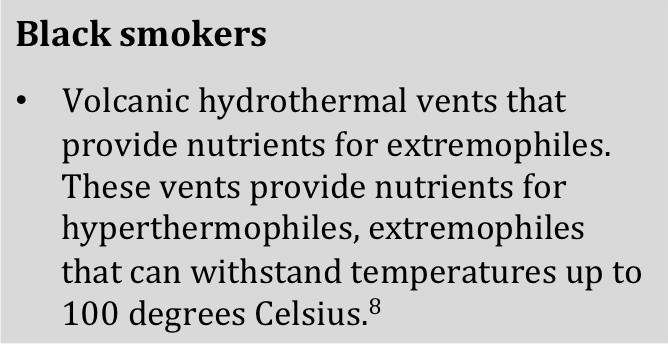
This kind of environment is far too hot, toxic, and anoxic for the life we are used to seeing on the surface, but the hyperthermophiles thrive. Scientists think that the existence of such organisms on Earth could mean that similar life could thrive in the harsh conditions on Europa, and some have been studying extremophiles on Earth to use as a model for what life may be found there.8 Because Europa’s global ocean is thought to be in contact with a rocky core, any geological activity in the core could leach nutrients into the ocean. If Europa is geologically active enough this energy exchange could look a lot like Earth’s black smokers, and maybe even house similar life. In contrast to Europa, Ganymede’s ocean is thought to be bounded by water ice, so this transfer of energy would not be possible.9
Does Europa Meet the Requirements for Life?
Life that is bigger and more complex than simple microorganisms is unlikely to be found on Europa, as the ocean is almost completely cut off from sunlight. This means there can be no photosynthesis for any life under the icy crust,10 making energy sources in short supply. The fact that life, as we know it, is intimately connected to liquid water is widely accepted amongst scientists, allowing the search for liquid water to drive the search for life in the Solar System.8 In this sense, combined with our knowledge of extremophiles, Europa seems like an excellent candidate for life. There are some, however, who think that liquid water and hypothesized volcanic activity is not enough to sustain life.
James Dohm of the Tokyo Institute of Technology believes Europa should not be considered as a candidate for life, based on his model called the Habitable Trinity. Under this model, an environment must have an atmosphere, ocean, and a landmass so that nutrients can cycle through them and consistently provide energy for life.11 Earth fits this model: the atmosphere provides carbon and nitrogen, the ocean provides water and oxygen, and the landmass provides essential nutrients such as calcium, iron, phosphorus, and potassium. All three aspects cycle amongst one another to enrich the Earth with the capacity for complex life.11 Under the Habitable Trinity model, Europa is a poor candidate for complex lifeforms. It has no continental crust or atmosphere to provide nutrients, and so there is no continuous cycle of energy similar to the cycle which exists on Earth.11
Despite skepticism, the search for life on Europa is far from over. Extremophiles studied on Earth prove that life can survive in even the harshest conditions. We only have one sample of what life in the Universe could look like: our own planet. We do not know very much about how life arises, but based on our current knowledge, Europa has plenty of redeeming qualities. If we were to find life on Europa, it would spark a new scientific age and give us a sense of how much life may exist out there.
Limitations of Human Life on Europa
If humans are going to colonise other bodies in our solar system, there are a few essential ingredients that we would need, and water is one of them. Europa has water, but what about the hazards? When it comes to evaluating the limiting factors of terrestrial life on Europa, quantifying risk levels is a difficult and laborious task due to the distance of travel to the surface and resources required for proper examination. Therefore, the discussion on inhibiting factors remains mostly speculative. One of the main risks to consider is the geological activity of this celestial body. Europa displays significant tectonic terrain which could be a positive indicator of microbial life, but could also become an active hazard to human life. The previously discussed subducted sections of ice suggest geological activity,12 and without conclusive research on the stability of the ice any volatility of plate tectonics could expose the potential for dangerously explosive terrain events such as earthquakes, as well as the formation of harsh terrestrial structures.
Another condition to consider is gravity. Europa’s force of gravity is measurably proportionate to its small size, operating a gravitational magnitude that is only 13.4% of Earth’s. This creates a virtually non-existent atmosphere, and consequently no weather events.14 There would be no breathable air on Europa. Lower gravities such as that of Europa’s surface are also feared to cause negative side effects upon human health, affecting keystones of motion such as muscle mass, bone density, and a change in kinetic dynamics.15
High levels of radiation on Europa are another cause for concern. The perils that radioactive emissions impose on human health are well studied and greatly varied, not limited to radiation sickness and a range of cancerous diseases. Jupiter itself has a large radiation belt that releases threatening levels of radiation, reaching the surface of Europa. This could be harmful to human life without effective shielding.16
The least quantifiable of the limitations to human life on Europa is the speculated microbial life. At present on Earth, millions of pathogens and bacterial lifeforms pose fatal threats to human health. With this in mind, any current inhabitants of Europa could potentially lead to unfavorable interactions with human visitors.17
Expeditions in the future: Visiting Europa
There are a number of expeditions planned for visiting Europa in the near future. In 2011, NASA’s Juno mission was launched and is expected to reach Jupiter in 2016.2 Another vessel, the Jupiter-Europa Orbiter is planned for launch in 2020 and will be able to determine the depth and salinity of Europa’s ocean. It will also look for regions of shallow water within the ice by measuring the amount of hydrogen and oxygen.9 One of the most important concerns involved in the search for evidence of life on Europa is the potential for contamination by any expedition sent to Europa’s surface. Future expeditions must be careful not to contaminate the Europan ocean with microorganisms from Earth.10 NASA’s planetary protection policy is an international treaty which aims to prevent biological contamination.
Conclusion
All of the evidence presented shows that Europa has the potential of sustaining microbial life upon its surface. The existence of microbes is highly speculated, but evidence such as liquid water, cycloids, and geological activity, combined with our knowledge of extremophiles, suggests their potential existence. Despite this, there are certain factors that hinder current human exploration and habitation of the satellite. These include unstable plate tectonics, unpredictable interaction with speculated microbial life that may be harmful, low gravity effects on the human body, uninhabitable temperatures, and high levels of radiation.
References
1 P. Kelly, Observer’s Handbook 2010, (RASC, Toronto, CA, 2009), pp.219-223.
2 H.R. Smith, What is Jupiter,
(http://www.nasa.gov/audience/forstudents/5-8/features/nasa-knows/what-is-jupiter-58.ht)
3 F. Neubauer, Nature 395, 749 (1998).
4 R.Greenberg, Choice Reviews Online 43, 3 (2005)
5 R.Greenberg, Am. Sci. 90 (1), 48 (2002)
6 NASA, Solar System Exploration, (http://solarsystem.nasa.gov/planets/europa)
7 NASA, Solar System Exploration, (http://solarsystem.nasa.gov/planets/jupiter)
8 D. Stojanovic et al, Link Between Earth and Astrobiology,
(http://www.doiserbia.nb.rs/Article.aspx?ID=0352-49060814005S#.VtpdY0tsAds), (2008)
9 R.T. Pappalardo, IAU 6, 101 (2010)
10 C. F. Chyba and C. B. Phillips, PNAS 98 (3), 801 (2001)
11 J. Dohm and S. Maruyama, Geoscience Frontiers 6, 95 (2015)
12 S. Kattenhorn, New Scientist 223, 17 (2014)
13 K. Hand, Nature 457, 384 (2009).
14 J. Castro, What Would It Be Like to Live on Jupiter’s Moon Europa,
(http://www.space.com/28705-how-to-live-on-europa.html), (2015)
15 S. Schmidt and R.Zubrin, Islands in the sky: bold new ideas for colonizing space, (Wiley,
New York, 1996), pp.85-94
16 N. Brice and T. Mcdonough, Icarus 18, 206 (1973)
17 N. Atkinson, Europa Capable of Supporting Life,
(http://www.universetoday.com/42303/europa-capable-of-supporting-life-scientist-says/),
(2009)
18 D. Backman and M. Seeds, The Solar System, 9th Ed. (Cengage Learning, Boston, 2016), pp.
138, 149, 233, 244, 307, 394
19 NAOAA, What is a Hydrothermal Vent, ( http://oceanservice.noaa.gov/facts/vents.html),
(2013)

